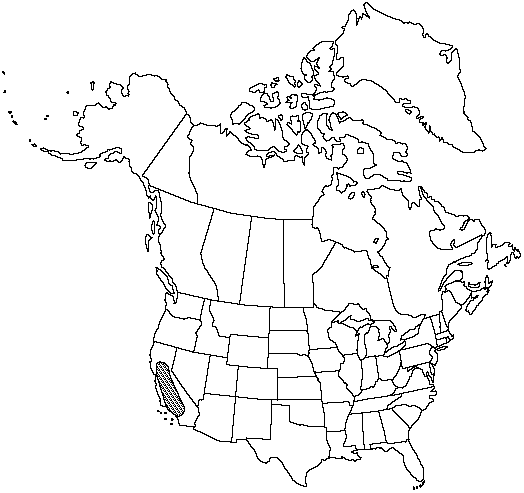Difference between revisions of "Cheilanthes cooperae"
Bull. Torrey Bot. Club 6: 33. 1875.
FNA>Volume Importer |
imported>Volume Importer |
||
| (7 intermediate revisions by 2 users not shown) | |||
| Line 8: | Line 8: | ||
}} | }} | ||
|common_names=Mrs. Cooper's lip fern | |common_names=Mrs. Cooper's lip fern | ||
| + | |special_status={{Treatment/ID/Special_status | ||
| + | |code=E | ||
| + | |label=Endemic | ||
| + | }} | ||
|basionyms= | |basionyms= | ||
|synonyms= | |synonyms= | ||
| Line 17: | Line 21: | ||
}}<!-- | }}<!-- | ||
| − | --><span class="statement" id="st- | + | --><span class="statement" id="st-undefined" data-properties=""><b>Stems </b>compact to short-creeping, usually 4–8 mm diam.; scales brown at base and darker toward tip, linear-subulate, straight to slightly contorted, loosely appressed, persistent. <b>Leaves</b> clustered, 5–30 cm; vernation circinate. <b>Petiole</b> dark brown, flattened or slightly grooved distally on adaxial surface. <b>Blade</b> linear-oblong to lanceolate-ovate, 3-pinnate at base, 1.5–5 cm wide; rachis flattened or slightly grooved adaxially, lacking scales, with monomorphic pubescence. <b>Pinnae</b> not articulate, dark color of stalk continuing into pinna base, basal pair slightly smaller than adjacent pair, ± equilateral, appearing hirsute adaxially. <b>Costae</b> green adaxially for most of length; abaxial scales absent. <b>Ultimate</b> segments linear-oblong to ovate, not beadlike, the largest 3–5 mm, abaxially and adaxially hirsute with long, strongly flattened hairs. <b>False</b> indusia marginal, weakly differentiated, 0.05–0.25 mm wide. <b>Sori</b> usually discontinuous, concentrated on apical and lateral lobes. <b>Sporangia</b> containing 64 spores. <b>2n</b> = 60.</span><!-- |
-->{{Treatment/Body | -->{{Treatment/Body | ||
| + | |phenology=Sporulating late spring–summer. | ||
|habitat=Calcareous cliffs and ledges, usually on limestone | |habitat=Calcareous cliffs and ledges, usually on limestone | ||
|elevation=100–700 m | |elevation=100–700 m | ||
|distribution=Calif. | |distribution=Calif. | ||
| − | |discussion=<p>Although scattered throughout much of California, Cheilanthes cooperae is apparently rare and quite localized. It appears to be most closely related to C. viscida, from which it differs in lacking glandular pubescence. The ranges of the two species do not overlap, and they seem amply distinct.</p> | + | |discussion=<p>Although scattered throughout much of California, <i>Cheilanthes cooperae</i> is apparently rare and quite localized. It appears to be most closely related to <i>C. viscida</i>, from which it differs in lacking glandular pubescence. The ranges of the two species do not overlap, and they seem amply distinct.</p> |
|tables= | |tables= | ||
|references= | |references= | ||
| Line 32: | Line 37: | ||
-->{{#Taxon: | -->{{#Taxon: | ||
name=Cheilanthes cooperae | name=Cheilanthes cooperae | ||
| − | |||
|authority=D. C. Eaton | |authority=D. C. Eaton | ||
|rank=species | |rank=species | ||
| Line 39: | Line 43: | ||
|basionyms= | |basionyms= | ||
|family=Pteridaceae | |family=Pteridaceae | ||
| + | |phenology=Sporulating late spring–summer. | ||
|habitat=Calcareous cliffs and ledges, usually on limestone | |habitat=Calcareous cliffs and ledges, usually on limestone | ||
|elevation=100–700 m | |elevation=100–700 m | ||
| Line 45: | Line 50: | ||
|publication title=Bull. Torrey Bot. Club | |publication title=Bull. Torrey Bot. Club | ||
|publication year=1875 | |publication year=1875 | ||
| − | |special status= | + | |special status=Endemic |
| − | |source xml=https:// | + | |source xml=https://bitbucket.org/aafc-mbb/fna-data-curation/src/2e0870ddd59836b60bcf96646a41e87ea5a5943a/coarse_grained_fna_xml/V2/V2_364.xml |
|genus=Cheilanthes | |genus=Cheilanthes | ||
|species=Cheilanthes cooperae | |species=Cheilanthes cooperae | ||
| − | |||
| − | |||
| − | |||
| − | |||
| − | |||
| − | |||
| − | |||
| − | |||
| − | |||
| − | |||
| − | |||
| − | |||
| − | |||
| − | |||
| − | |||
| − | |||
| − | |||
| − | |||
| − | |||
| − | |||
| − | |||
| − | |||
| − | |||
| − | |||
| − | |||
| − | |||
| − | |||
| − | |||
| − | |||
| − | |||
| − | |||
| − | |||
| − | |||
| − | |||
| − | |||
| − | |||
| − | |||
| − | |||
| − | |||
| − | |||
| − | |||
}}<!-- | }}<!-- | ||
-->[[Category:Treatment]][[Category:Cheilanthes]] | -->[[Category:Treatment]][[Category:Cheilanthes]] | ||
Latest revision as of 21:23, 5 November 2020
Stems compact to short-creeping, usually 4–8 mm diam.; scales brown at base and darker toward tip, linear-subulate, straight to slightly contorted, loosely appressed, persistent. Leaves clustered, 5–30 cm; vernation circinate. Petiole dark brown, flattened or slightly grooved distally on adaxial surface. Blade linear-oblong to lanceolate-ovate, 3-pinnate at base, 1.5–5 cm wide; rachis flattened or slightly grooved adaxially, lacking scales, with monomorphic pubescence. Pinnae not articulate, dark color of stalk continuing into pinna base, basal pair slightly smaller than adjacent pair, ± equilateral, appearing hirsute adaxially. Costae green adaxially for most of length; abaxial scales absent. Ultimate segments linear-oblong to ovate, not beadlike, the largest 3–5 mm, abaxially and adaxially hirsute with long, strongly flattened hairs. False indusia marginal, weakly differentiated, 0.05–0.25 mm wide. Sori usually discontinuous, concentrated on apical and lateral lobes. Sporangia containing 64 spores. 2n = 60.
Phenology: Sporulating late spring–summer.
Habitat: Calcareous cliffs and ledges, usually on limestone
Elevation: 100–700 m
Discussion
Although scattered throughout much of California, Cheilanthes cooperae is apparently rare and quite localized. It appears to be most closely related to C. viscida, from which it differs in lacking glandular pubescence. The ranges of the two species do not overlap, and they seem amply distinct.
Selected References
None.
